Shear Reinforcement Effectiveness of One-Way Void Slab with the Hollow Core Ratio and Shear Reinforcement
Abstract
:1. Introduction
2. Experimental Programme
2.1. Shear Capacity Calculation by Various Standards
2.1.1. ACI 318-14
2.1.2. Uniform Building Code
2.1.3. CEB-FIP 1990
2.2. Experimental Programme Details
2.2.1. Specimen Design
2.2.2. Fabrication of Void Slab for Test Specimens
- (1)
- Formwork construction: plywood formwork was constructed to replicate the desired dimensions of the reinforced concrete void slabs.
- (2)
- (3)
- Rebar securing: to prevent the buoyancy of the fresh concrete from displacing the hollow core during the pouring process, additional fixing reinforcement bars were strategically placed. These bars ensured the hollow core remained in the intended position within the formwork.
- (4)
- Concrete placement and curing: once all reinforcement elements, including the fixing bars, were positioned as per the designated layout (see Figure 2), concrete was carefully poured into the formwork. Standard curing procedures were followed to ensure proper hydration and strength development of the concrete.
2.2.3. Material Properties of the Test Specimens
2.3. Test Setup and Instrumental for Shear Performance Evaluation
3. Experimental Results and Analysis
3.1. Load–Displacement Behaviours
3.2. Crack Patterns
4. Performance Evaluation of Void Slab with Shear Reinforcement
4.1. Shear Capacity Evaluation Based on Standard Formulae in Different Codes
4.1.1. ACI 318-14
- The expected shear strength of unreinforced specimens varied. It ranged from a minimum value of 1.95 for HC-35 (likely indicating a void ratio of 35%) to a maximum of 2.14 for HC-40 (likely indicating a hollow core ratio of 40%). On average, the expected shear strength for this group was 2.07. The data also showed some variation within the group, with a variance of 0.011 and a standard deviation of 0.107.
- Specimens with a 45-degree shear reinforcement exhibited a clear benefit in terms of consistency compared to unreinforced specimens. This group displayed a noticeably narrower range of expected shear strengths, varying from a minimum of 1.55 to a maximum of 1.64. Additionally, the average expected shear strength for the 45-degree group was 1.60.
- This improved consistency is further supported by the lower variance (0.002) and standard deviation (0.046) observed in the data. These reduced values suggest that a 45-degree shear reinforcement helps to achieve more predictable results in terms of expected shear strength.
- Similar to the unreinforced specimens, the expected shear strength of specimens with a 90-degree reinforcement also varied based on void ratio. The minimum value observed was 1.44 for both HC-35-90 and HC-40-90 (likely indicating void ratios of 35% and 40%, respectively). This value increased to a maximum of 1.62 for HC-30-90 (likely indicating a void ratio of 30%).
- The average expected shear strength for the 90-degree group was 1.50, with a variance of 0.011 and a standard deviation of 0.104. While a 90-degree reinforcement may not entirely eliminate the influence of the void ratio, these findings suggest it can offer some improvement in achieving more consistent shear strength compared to unreinforced specimens.
4.1.2. UBC 2
- Building upon the findings from the ACI code analysis (Section 4.1.1), unreinforced specimens continued to exhibit a range of expected shear strengths. This variation spanned from a minimum value of 1.97 for HC-35 (void ratio of 35%) to a maximum value of 2.16 for both HC-40 and HC-30 (void ratios of 40 and 30%, respectively). The average expected shear strength for this group was 2.10. Additionally, the variance and standard deviation were 0.012 and 0.11, respectively (See Table 6).
- In contrast to the unreinforced specimens, those with a 45-degree shear reinforcement displayed a significantly narrower range of expected shear strengths. This range varied from a minimum of 1.56 to a maximum of 1.65. Notably, the average expected shear strength for this group was 1.60.
- Furthermore, the variance (0.002) and standard deviation (0.046) were both considerably lower compared to the unreinforced group. These reduced values suggest a more consistent performance in terms of expected shear strength for specimens with a 45-degree reinforcement. This observation aligns with the findings from the ACI code analysis (Section 4.1.1), where similar trends were observed for 45-degree reinforced specimens.
- Similar to the observations for unreinforced and 45-degree reinforced specimens, the expected shear strength of specimens with a 90-degree reinforcement also exhibited variations based on the hollow core ratio. The minimum value was 1.45 for both HC-35-90 and HC-40-90 (void ratios of 35 and 40%, respectively). This value increased to a maximum of 1.63 for HC-30-90 (void ratio of 30%).
- The average expected shear strength for the 90-degree group was 1.51, with a variance of 0.011 and a standard deviation of 0.104. These findings suggest that the hollow core ratio remains a factor influencing expected shear strength even with a 90-degree reinforcement.
4.1.3. CEB-FIP 1990
- The results for 90-degree reinforced specimens presented an interesting observation. While they exhibited a wider range of expected shear strengths (1.41 to 1.63) compared to the 45-degree specimens, this range remained lower than that observed in the unreinforced group.
- The average expected shear strength for the 90-degree specimens was 1.49, with a variance of 0.015 and a standard deviation of 0.124. These findings suggest that while a 90-degree reinforcement may not offer the same level of consistency as a 45-degree reinforcement, it still provides some improvement compared to unreinforced specimens.
5. Conclusions
- Shear failure confirmation: The planned void slab specimens, designed according to ACI 318-14 for shear, all exhibited shear failure during load testing. This failure mode was further corroborated through the analysis of load–displacement curves and crack patterns.
- Enhanced shear capacity: All test specimens demonstrated a significant reserve of shear strength, exceeding the expected shear capacity calculated using ACI 318-14 by a minimum factor of 1.436. This observation suggests the potential for more efficient design approaches that capitalize on the actual shear resistance of these hollow slab configurations.
- Hollow core ratio and shear strength: An inverse relationship was observed between the porosity of the unreinforced specimens and their maximum shear strength. Specimens with higher porosity generally exhibited lower peak shear resistance. This finding highlights the influence of void content on the overall shear performance of hollow slabs.
- Comparative analysis of design codes: The expected shear strengths estimated using established design codes (ACI 318-14, UBC 2, and CEB-FIP 1990) were compared against the experimentally obtained maximum shear strengths. Among these codes, CEB-FIP 1990 demonstrated the closest agreement between predicted and actual shear capacity. This suggests that CEB-FIP 1990 may provide a more accurate representation of the shear behaviour for this specific type of hollow slab with shear reinforcement.
Author Contributions
Funding
Data Availability Statement
Conflicts of Interest
References
- Cho, S.; Na, S. Evaluation of the Flexural Performance and CO2 Emissions of the Voided Slab. Adv. Mater. Sci. Eng. 2018, 2018, 3817580. [Google Scholar] [CrossRef]
- Ibrahim, I.; Elliott, K.; Abdullah, R.; Kueh, A.; Sarbini, N. Experimental study on the shear behaviour of precast concrete hollow core slabs with concrete topping. Eng. Struct. 2016, 125, 80–90. [Google Scholar] [CrossRef]
- Monisha, K.; Srinivasan, G. Experimental behaviour of prestress hollow core slab, RC hollow core slab and normal RC solid slab. Int. Res. J. Eng. Technol. 2017, 4, 1090–1093. [Google Scholar]
- Heo, S.; Na, S.; Choi, W. Serviceability Evaluation of High-Rise Buildings Exposed to Typhoon Proximity Effects Using ISO10137 and ISO6897. Buildings 2023, 13, 2119. [Google Scholar] [CrossRef]
- Teja, P.P.; Kumar, P.V.; Anusha, S.; Mounika, C.H.; Saha, P. Structural behavior of bubble deck slab. In Proceedings of the IEEE-International Conference on Advances in Engineering, Science and Management (ICAESM-2012), Nagapattinam, India, 30–31 March 2012. [Google Scholar]
- Muttoni, A. Punching shear strength of reinforced concrete slabs without transverse reinforcement. ACI Struct. J. 2008, 105, 440–450. [Google Scholar]
- Guandalini, S.; Burdet, O.; Muttoni, A. Punching tests of slabs with low reinforcement ratios. ACI Struct. J. 2009, 106, 87–95. [Google Scholar]
- Marí, A.; Bairán, J.; Cladera, A.; Oller, E.; Ribas, C. Shear-flexural strength mechanical model for the design and assessment of reinforced concrete beams. Struct. Infrastruct. Eng. 2015, 11, 1399–1419. [Google Scholar] [CrossRef]
- Alrousan, R.Z.; Bara’a, R.A. The influence of concrete compressive strength on the punching shear capacity of reinforced concrete flat slabs under different opening configurations and loading conditions. In Structures; Elsevier: Amsterdam, The Netherlands, 2022. [Google Scholar]
- Na, S.; Paik, I. Reducing greenhouse gas emissions and costs with the alternative structural system for slab: A comparative analysis of South Korea cases. Sustainability 2019, 11, 5238. [Google Scholar] [CrossRef]
- Elstner, R.C.; Hognestad, E. Shearing strength of reinforced concrete slabs. J. Proc. 1956, 53, 29–58. [Google Scholar]
- Zineddin, M.; Krauthammer, T. Dynamic response and behavior of reinforced concrete slabs under impact loading. Int. J. Impact Eng. 2007, 34, 1517–1534. [Google Scholar] [CrossRef]
- Huang, Y.; Grünewald, S.; Schlangen, E.; Luković, M. Strengthening of concrete structures with ultra high performance fiber reinforced concrete (UHPFRC): A critical review. Constr. Build. Mater. 2022, 336, 127398. [Google Scholar] [CrossRef]
- Pilakoutas, K.; Li, X. Alternative shear reinforcement for reinforced concrete flat slabs. J. Struct. Eng. 2003, 129, 1164–1172. [Google Scholar] [CrossRef]
- Paik, I.; Na, S. Comparison of carbon dioxide emissions of the ordinary reinforced concrete slab and the voided slab system during the construction phase: A case study of a residential building in South Korea. Sustainability 2019, 11, 3571. [Google Scholar] [CrossRef]
- Paik, I.; Na, S.; Yoon, S. Assessment of CO2 emissions by replacing an ordinary reinforced concrete slab with the void slab system in a high-rise commercial residential complex building in South Korea. Sustainability 2018, 11, 82. [Google Scholar] [CrossRef]
- Na, S.; Paik, I.; Yun, S.-H.; Truong, H.C.; Roh, Y.-S. Evaluation of the floor impact sound insulation performance of a voided slab system applied to a high-rise commercial residential-complex building. Int. J. Concr. Struct. Mater. 2019, 13, 3. [Google Scholar] [CrossRef]
- Wang, L. Vulnerability evaluation of high-rise earthquake-proof buildings in high-pressure area. Int. J. Ind. Syst. Eng. 2021, 39, 361–376. [Google Scholar] [CrossRef]
- Heo, S.; Na, S.; Hur, M.-W.; Lee, S. Evaluating the Vertical Extension Module of a Building with Installed Rotary Dampers at Joints. Buildings 2021, 11, 536. [Google Scholar] [CrossRef]
- Lee, S.-J.; Choi, K.-K.; Lee, J.-E.; Dinh, N.H.; Park, W.-I. Hysteresis response of rotary friction dampers developed for seismic operational performance of non-structural components vulnerable to overturning. In Structures; Elsevier: Amsterdam, The Netherlands, 2022. [Google Scholar]
- Paik, I.; Na, S. Evaluation of carbon dioxide emissions amongst alternative slab systems during the construction phase in a building project. Appl. Sci. 2019, 9, 4333. [Google Scholar] [CrossRef]
- Paik, I.; Na, S. Comparison of environmental impact of three different slab systems for life cycle assessment of a commercial building in South Korea. Appl. Sci. 2020, 10, 7278. [Google Scholar] [CrossRef]
- Jabir, H.A.; Mhalhal, J.M.; Al-Gasham, T.S. Conventional and bubbled slab strips under limited repeated loads: A comparative experimental study. Case Stud. Constr. Mater. 2021, 14, e00501. [Google Scholar] [CrossRef]
- Al-Gasham, T.S.; Mhalhal, J.M.; Abid, S.R. Quasi-static analysis of biaxial voided slabs with openings. In Structures; Elsevier: Amsterdam, The Netherlands, 2021. [Google Scholar]
- Kıpçak, F.; Erdil, B.; Tapan, M.; Karaşin, A. The Effect of Voids on Flexural Capacity of Reinforced Concrete Slabs. Period. Polytech. Civ. Eng. 2023, 67, 1048–1065. [Google Scholar] [CrossRef]
- Zavalis, M.; Daugevičius, M.; Jokūbaitis, A.; Zavalis, R.; Valivonis, J. Deflection estimation model for prestressed concrete slabs with plastic inserts forming voids. Materials 2022, 15, 3013. [Google Scholar] [CrossRef] [PubMed]
- Barreto, M.M.; Timm, J.; Passuello, A.; Molin, D.D.; Masuero, J. Life cycle costs and impacts of massive slabs with varying concrete cover. Clean. Eng. Technol. 2021, 5, 100256. [Google Scholar] [CrossRef]
- Sampaio, D.O.; Tashima, M.M.; Costa, D.; Quinteiro, P.; Dias, A.C.; Akasaki, J.L. Evaluation of the environmental performance of rice husk ash and tire rubber residues incorporated in concrete slabs. Constr. Build. Mater. 2022, 357, 129332. [Google Scholar] [CrossRef]
- Paik, I.-K.; Na, S. Evaluation of Noise Insulation Performance for Void Deck Slab System which Combines Deck Plates with a Voided Slab System. Int. J. Appl. Eng. Res. 2018, 13, 7348–7359. [Google Scholar]
- Park, S.; Moges, K.A.; Pyo, S. Experimental study on the sound absorption performance of surface-perforated mortar. Constr. Build. Mater. 2021, 307, 124824. [Google Scholar] [CrossRef]
- Kim, K.W.; Shin, H.K.; Park, J.-Y.; Chung, J.Y. Vibration and Floor Impact Sound Isolation Performance in Bubble Deck Slab. Key Eng. Mater. 2018, 777, 523–527. [Google Scholar] [CrossRef]
- Xu, J.; Wu, C.; Li, Z.-X. Analysis of direct shear failure mode for RC slabs under external explosive loading. Int. J. Impact Eng. 2014, 69, 136–148. [Google Scholar] [CrossRef]
- Eom, T.-S.; Hwang, I.-H.; Lee, S.-J.; Park, T.-W. Failure Mode and Shear Strength of Nonprestressed Hollow-Core Slabs in One-Way Shear. ACI Struct. J. 2018, 115, 1131–1142. [Google Scholar] [CrossRef]
- Varshney, H.; Jauhari, N.; Bhatt, H. A review study on bubble deck slab. Int. J. Res. Appl. Sci. Eng. Technol. 2017, 5, 2136–2139. [Google Scholar] [CrossRef]
- Gamal, M.; Heiza, K.; Hekal, G.M.; Nabil, A. Voided slabs as a new construction technology—A review. In Proceedings of the International Conference on Advances in Structural and Geotechnical Engineering, Hurghada, Egypt, 6–9 March 2023. [Google Scholar]
- Adil, A.I.; Hejazi, F.; Rashid, R.S. Voided biaxial slabs-state of art. In IOP Conference Series: Earth and Environmental Science; IOP Publishing: Bristol, UK, 2019. [Google Scholar]
- Adenan, D.; Kamaruddin, K.; Saman, H.M. Bubble deck slab technology as an alternative slab system—A review. In AIP Conference Proceedings; AIP Publishing: Long Island, NY, USA, 2023. [Google Scholar]
- Biradar, R.; Nikam, V.; Sonawane, S. A review of comparative study between conventional slab and bubble deck slab. Int. Res. J. Eng. Technol. 2020, 7, 470–472. [Google Scholar]
- ACI Committee 318, ACI CODE-318-14: Building Code Requirements for Structural Concrete and Commentary; ACI Concrete: Farmington Hills, MI, USA, 2014.
- Uniform Building Code. Uniform Building Code; International Conference of Building Officials: Whittier, CA, USA, 1997. [Google Scholar]
- Comité Euro-International du Béton. CEB-FIP Model Code 1990: Design Code; Thomas Telford Publishing: London, UK, 1993. [Google Scholar]
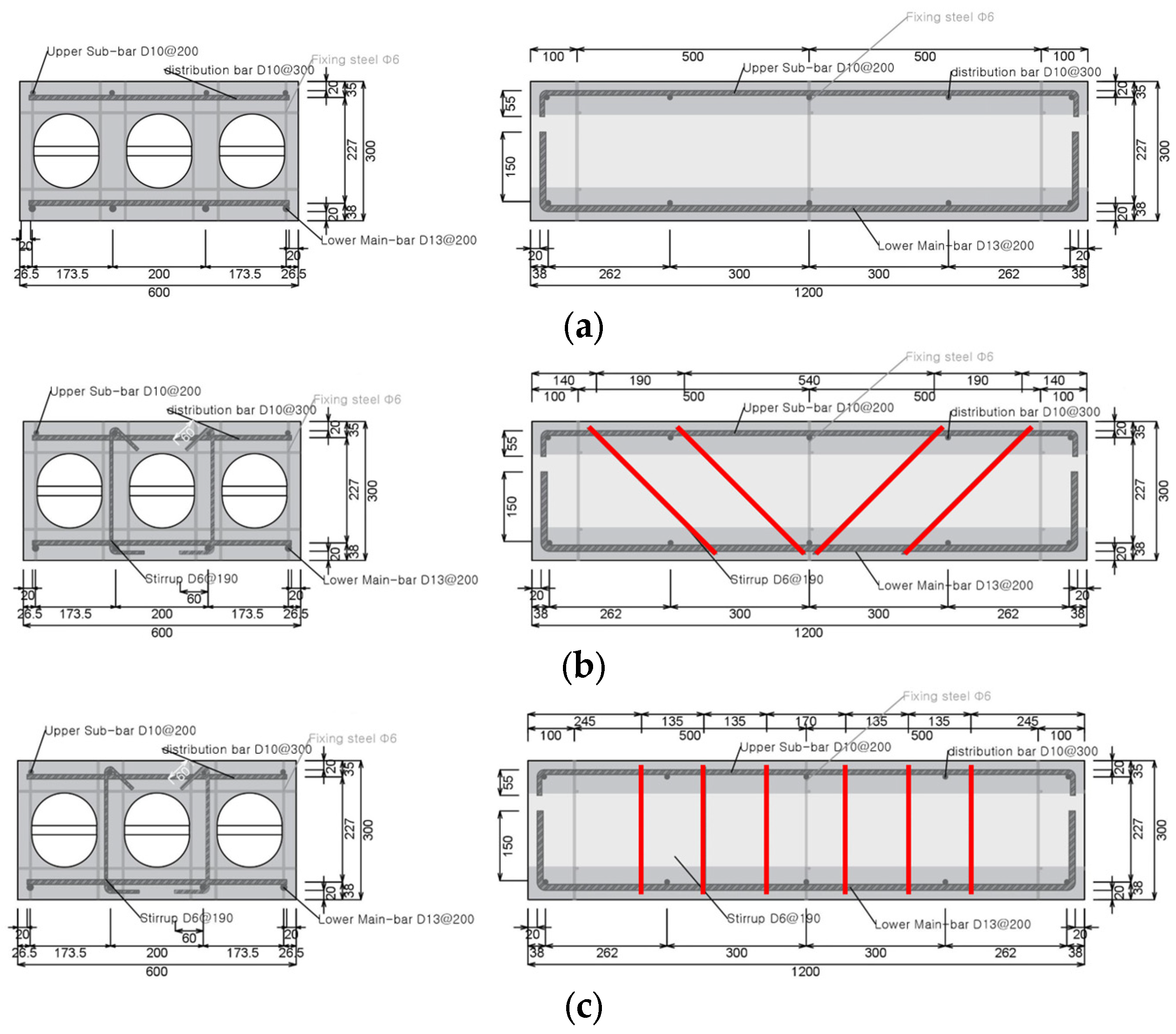
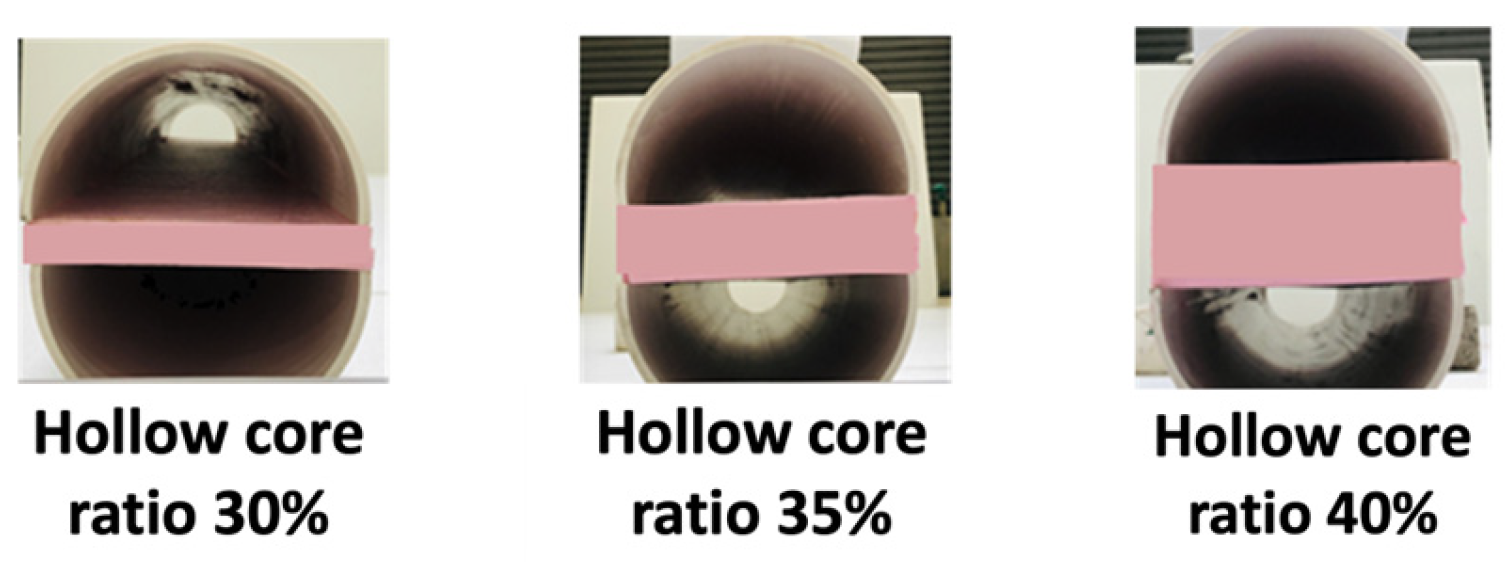
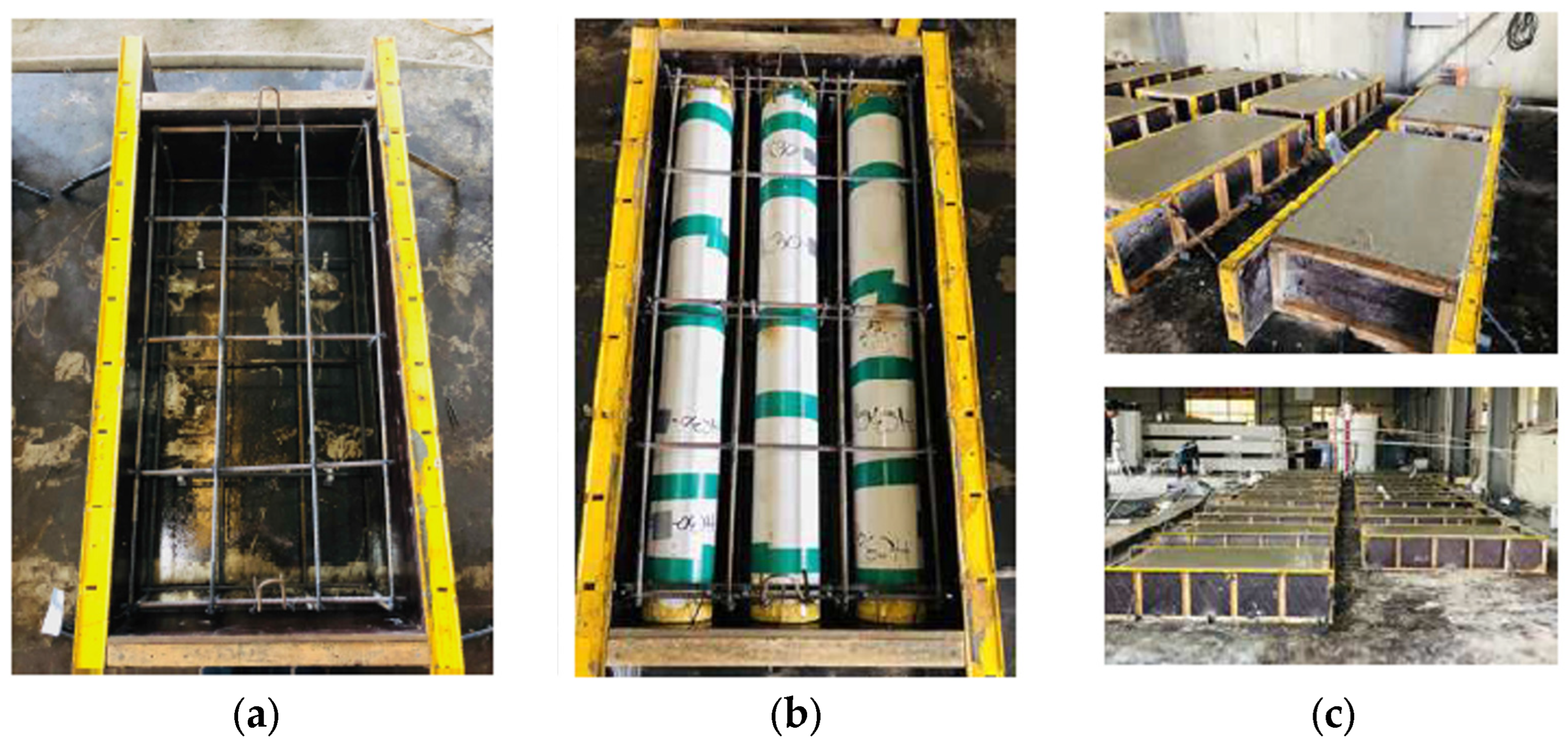


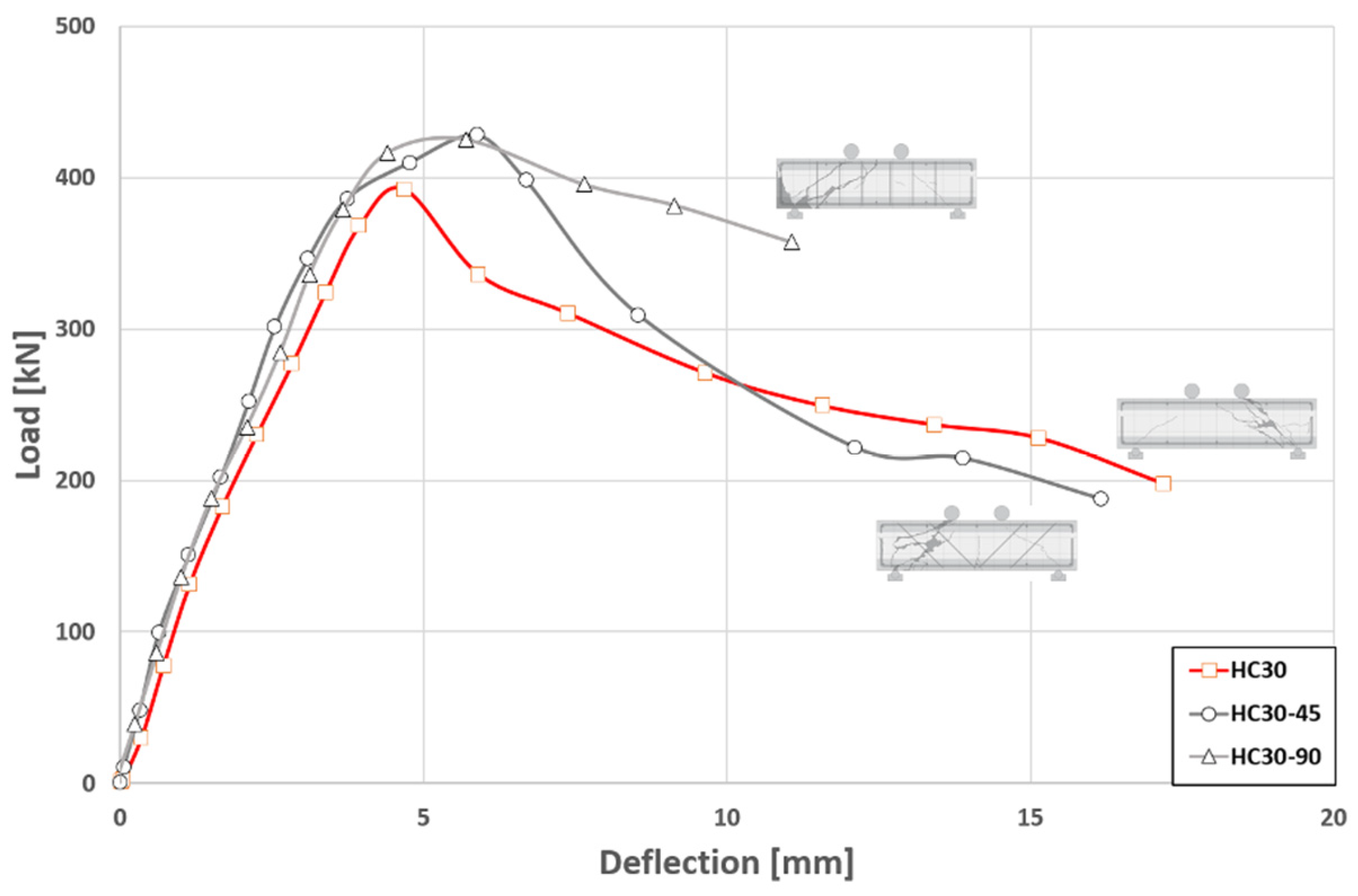

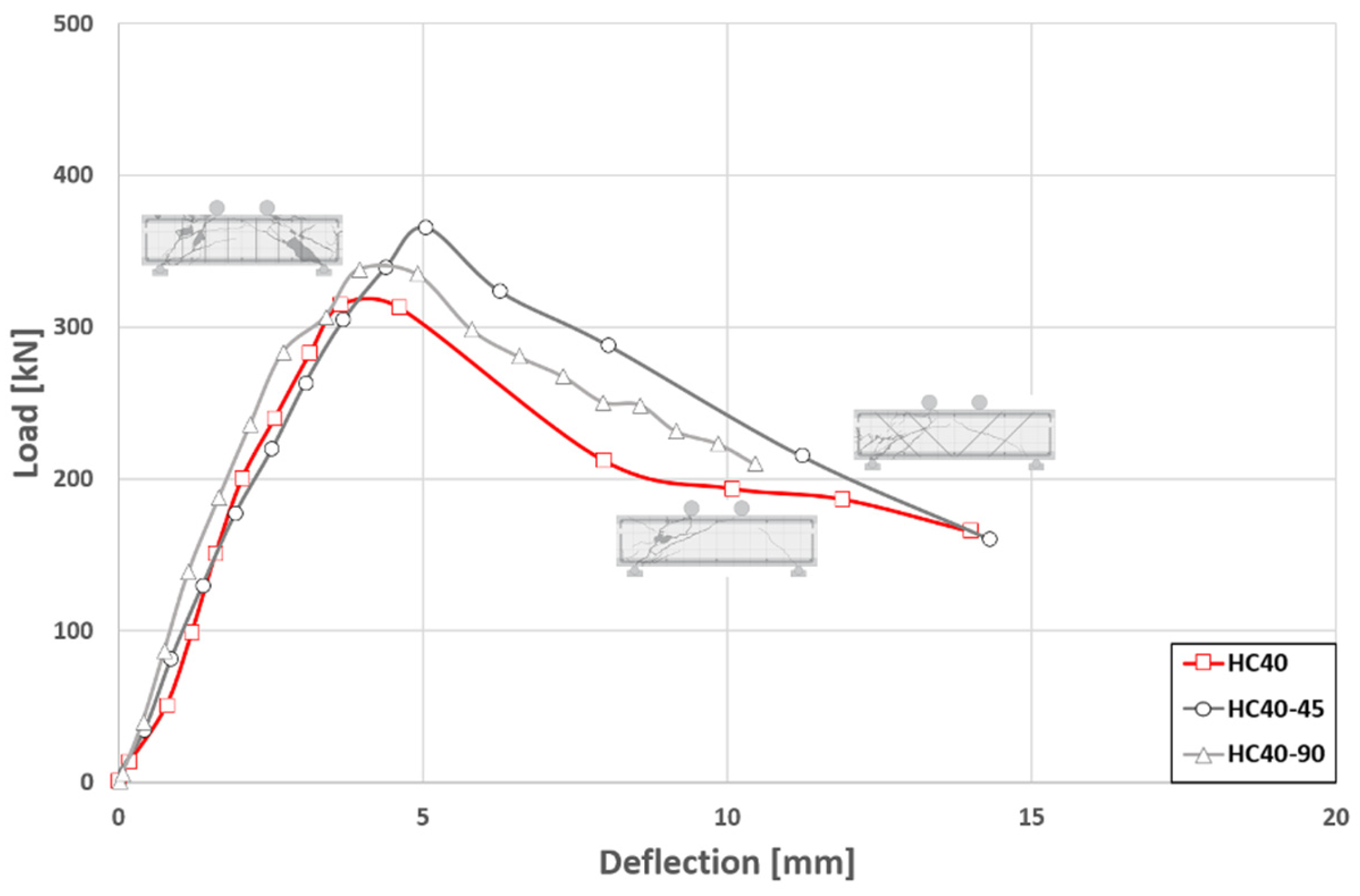
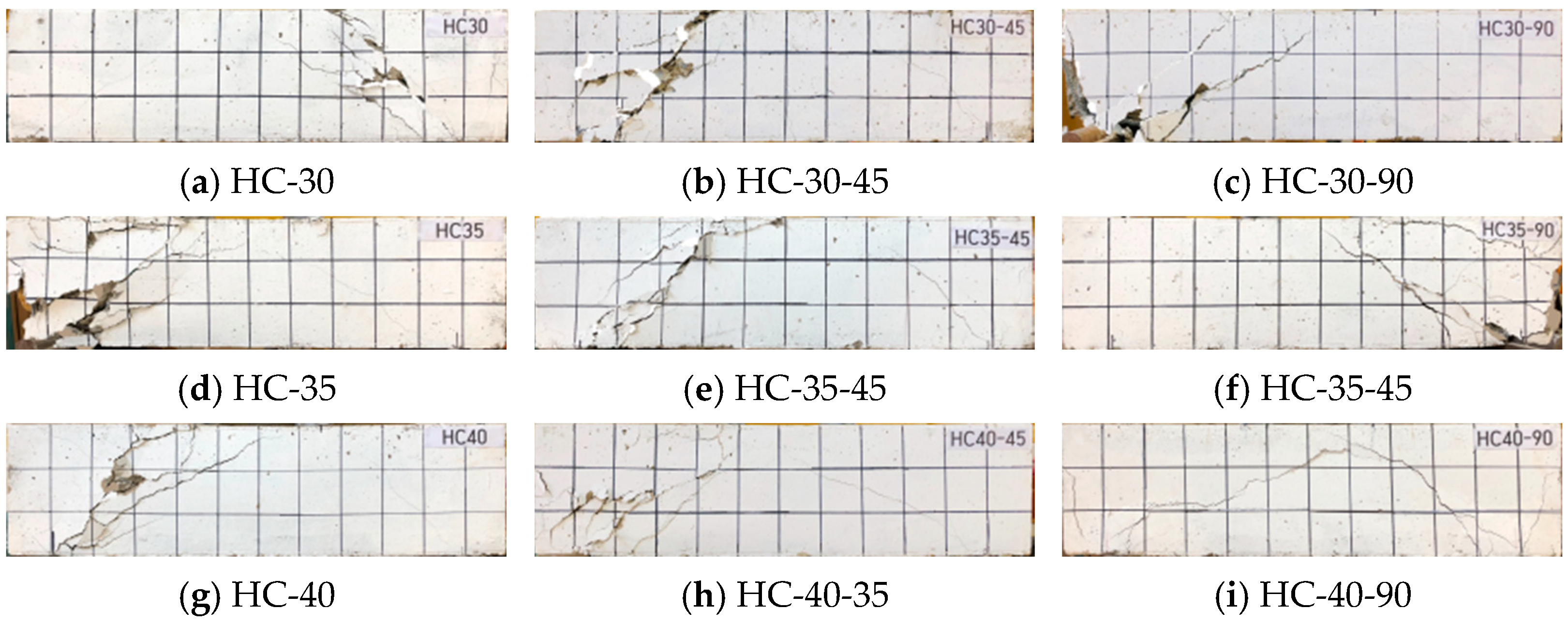

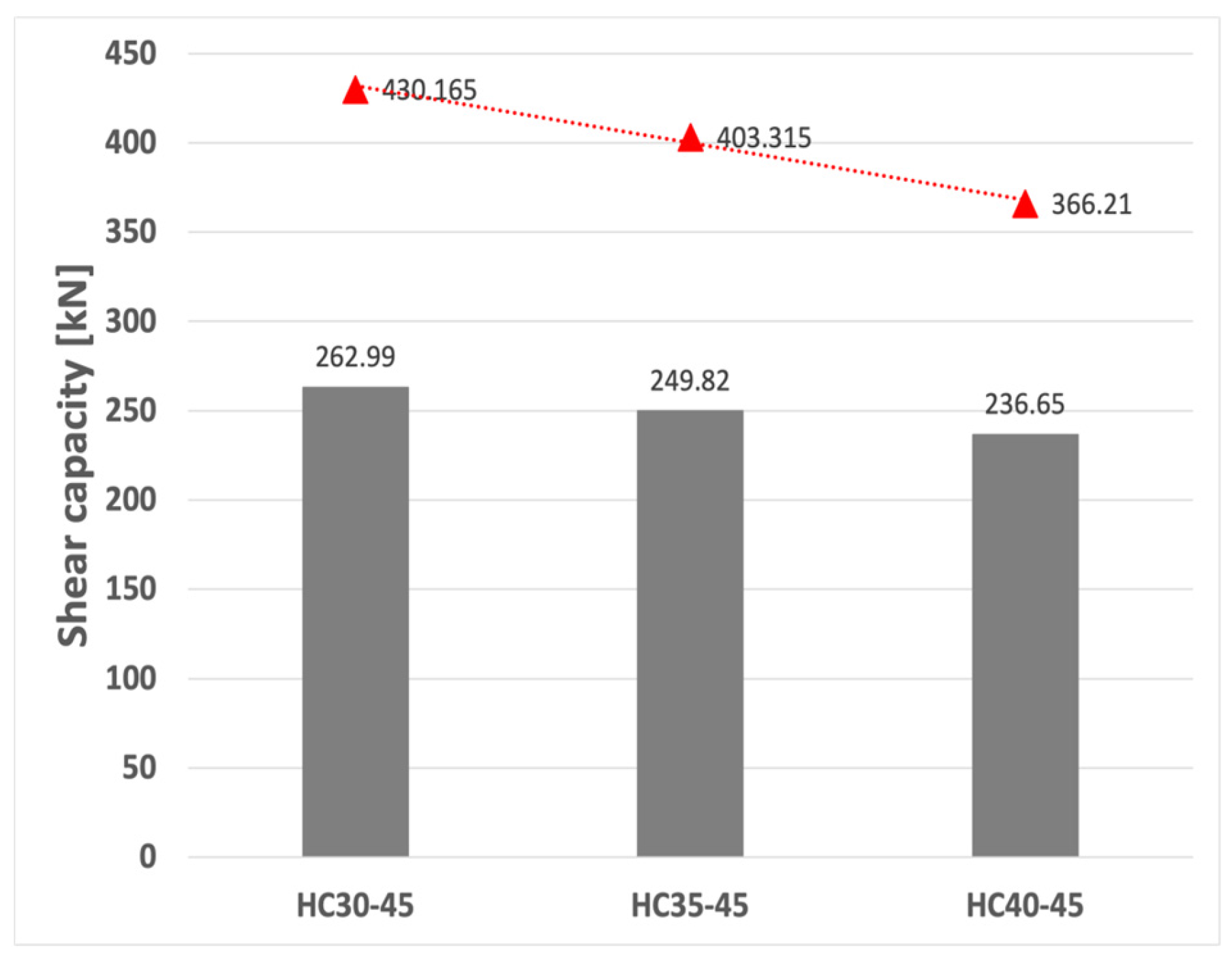
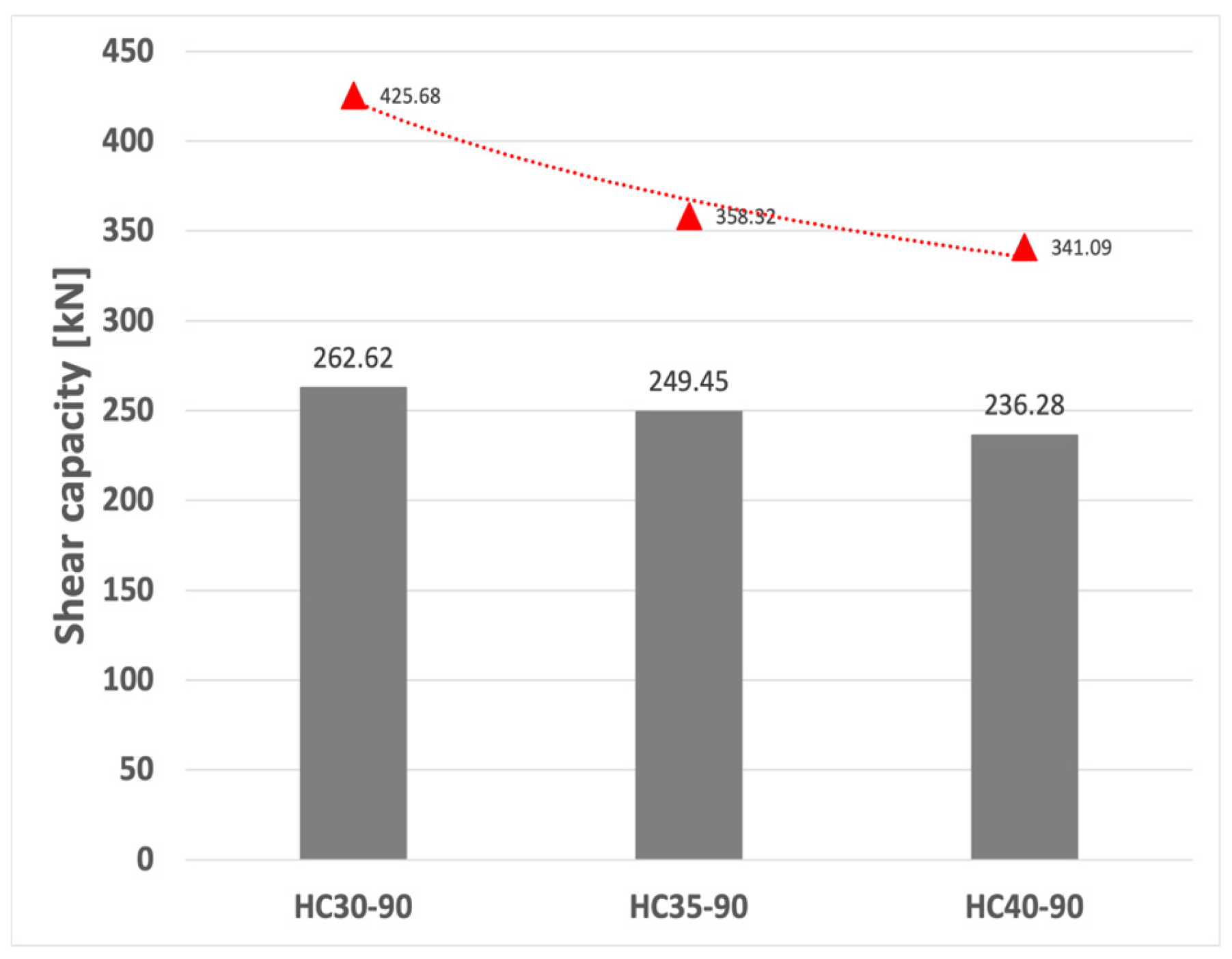
| Specimen | Hollow Core Ratio (%) | Shear Reinforcement |
|---|---|---|
| HC-30 | 30.32 | None |
| HC-30-45 | 30.32 | 45° reinforcement |
| HC-30-90 | 30.32 | 90° reinforcement |
| HC-35 | 34.99 | None |
| HC-35-45 | 34.99 | 45° reinforcement |
| HC-35-90 | 34.99 | 90° reinforcement |
| HC-40 | 39.66 | None |
| HC-40-45 | 39.66 | 45° reinforcement |
| HC-40-90 | 39.66 | 90° reinforcement |
| W/C (%) | S/a (%) | Unit Material Requirements (kg/m3) | |||
|---|---|---|---|---|---|
| Water | Cement | Fine Aggregate | Coarse Aggregate | ||
| 47.8 | 47.5 | 170 | 356 | 848 | 956 |
| Concrete (MPa) | Rebar (MPa) | |||
|---|---|---|---|---|
| Design Strength | Compressive Strength | D13 | D10 | D6 |
| 24.0 | 24.999 | 565.1 | 598.6 | 335.2 |
| Specimen | Expected Shear Capacity (kN) | Experimental Shear Capacity (kN) | Experimental/Expected Shear Capacity |
|---|---|---|---|
| HC-30 | 185.88 | 395.505 | 2.128 |
| HC-30-45 | 262.99 | 430.165 | 1.636 |
| HC-30-90 | 262.62 | 425.68 | 1.621 |
| HC-35 | 172.38 | 335.80 | 1.948 |
| HC-35-45 | 249.85 | 403.315 | 1.614 |
| HC-35-90 | 249.45 | 358.32 | 1.436 |
| HC-40 | 159.21 | 340.905 | 2.141 |
| HC-40-45 | 236.65 | 366.21 | 1.547 |
| HC-40-90 | 236.28 | 341.09 | 1.444 |
| No Reinforcement | 45° Reinforcement | 90° Reinforcement | |||||||
|---|---|---|---|---|---|---|---|---|---|
| Name | HC-30 | HC-35 | H-C40 | HC-30-45 | HC-35-45 | HC-40-45 | H-C30-90 | HC-35-90 | HC-40-90 |
| Vtest (kN) | 395.5 | 335.8 | 340.9 | 430.2 | 403.3 | 366.2 | 425.7 | 358.3 | 341.1 |
| VACI | 185.9 | 172.4 | 159.2 | 263.0 | 249.8 | 236.7 | 262.6 | 249.5 | 236.3 |
| Vtest/VACI | 2.13 | 1.95 | 2.14 | 1.64 | 1.61 | 1.55 | 1.62 | 1.44 | 1.44 |
| AVG. | 2.07 | 1.6 | 1.5 | ||||||
| Var. | 0.011 | 0.002 | 0.011 | ||||||
| S.D. | 0.107 | 0.046 | 0.104 | ||||||
| No Reinforcement | 45° Reinforcement | 90° Reinforcement | |||||||
|---|---|---|---|---|---|---|---|---|---|
| Name | HC-30 | HC-35 | H-C40 | HC-30-45 | HC-35-45 | HC-40-45 | H-C30-90 | HC-35-90 | HC-40-90 |
| Vtest (kN) | 395.5 | 335.8 | 340.9 | 430.2 | 403.3 | 366.2 | 425.7 | 358.3 | 341.1 |
| VUBC | 183.5 | 170.5 | 157.5 | 260.9 | 247.9 | 234.9 | 260.6 | 247.6 | 234.5 |
| Vtest/VUBC | 2.16 | 1.97 | 2.16 | 1.65 | 1.63 | 1.56 | 1.63 | 1.45 | 1.45 |
| AVG. | 2.1 | 1.61 | 1.51 | ||||||
| Var. | 0.012 | 0.002 | 0.011 | ||||||
| S.D. | 0.11 | 0.047 | 0.104 | ||||||
| No Reinforcement | 45° Reinforcement | 90° Reinforcement | |||||||
|---|---|---|---|---|---|---|---|---|---|
| Name | HC-30 | HC-35 | H-C40 | HC-30-45 | HC-35-45 | HC-40-45 | H-C30-90 | HC-35-90 | HC-40-90 |
| Vtest (kN) | 395.5 | 335.8 | 340.9 | 430.2 | 403.3 | 366.2 | 426.7 | 358.3 | 341.1 |
| VCEB | 182.9 | 173.4 | 163.7 | 287.9 | 278.4 | 268.6 | 261.3 | 251.8 | 242.0 |
| Vtest/VCEB | 2.16 | 1.94 | 163.7 | 1.49 | 1.45 | 1.36 | 1.63 | 1.42 | 1.41 |
| AVG. | 2.06 | 1.43 | 1.49 | ||||||
| Var. | 0.012 | 0.004 | 0.015 | ||||||
| S.D. | 0.111 | 0.067 | 0.124 | ||||||
Disclaimer/Publisher’s Note: The statements, opinions and data contained in all publications are solely those of the individual author(s) and contributor(s) and not of MDPI and/or the editor(s). MDPI and/or the editor(s) disclaim responsibility for any injury to people or property resulting from any ideas, methods, instructions or products referred to in the content. |
© 2024 by the authors. Licensee MDPI, Basel, Switzerland. This article is an open access article distributed under the terms and conditions of the Creative Commons Attribution (CC BY) license (https://creativecommons.org/licenses/by/4.0/).
Share and Cite
Cho, S.; Na, S.; Ha, J. Shear Reinforcement Effectiveness of One-Way Void Slab with the Hollow Core Ratio and Shear Reinforcement. Appl. Sci. 2024, 14, 4737. https://doi.org/10.3390/app14114737
Cho S, Na S, Ha J. Shear Reinforcement Effectiveness of One-Way Void Slab with the Hollow Core Ratio and Shear Reinforcement. Applied Sciences. 2024; 14(11):4737. https://doi.org/10.3390/app14114737
Chicago/Turabian StyleCho, Seungho, Seunguk Na, and Jungsoo Ha. 2024. "Shear Reinforcement Effectiveness of One-Way Void Slab with the Hollow Core Ratio and Shear Reinforcement" Applied Sciences 14, no. 11: 4737. https://doi.org/10.3390/app14114737





